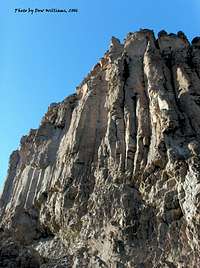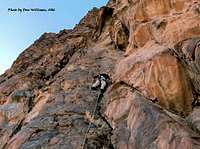-
 35291 Hits
35291 Hits
-
 90.48% Score
90.48% Score
-
 32 Votes
32 Votes
|
|
Area/Range |
|---|---|
|
|
35.73528°N / 106.14639°W |
|
|
Trad Climbing, Sport Climbing |
|
|
Spring, Summer, Fall, Winter |
|
|
6600 ft / 2012 m |
|
|
Overview/Routes
We have visited Santa Fe and Taos, New Mexico on quite a few occasions during the past 15 years. Most of these visits were completely focused on skiing. This past March (2006) we had some sunny weather and were in the mood for rock climbing. We set out to explore Diablo Canyon just 15 miles northwest of Santa Fe. Diablo Canyon is jointly administered by the BLM and U.S. Forest Service and is fairly new by climbing standards. Most routes were not established until the 80’s and 90’s. Even though it is the closest significant climbing area to Santa Fe, most folks don’t visit Santa Fe to climb, so it appears to be sparsely visited compared to our many southwestern haunts.
The hard dark basalt of Diablo Canyon is similar to Devil’s Tower in Wyoming and offers some of the best multi-pitch climbing in New Mexico. The cracks are the direct result of lava cooling. The 100+ routes range from 5.8 to 5.13. Diablo Canyon is divided up into four general areas with each featuring over 20 routes (trad and sport), Winter Wall, Early Wall, Grotto and Coxcomb Crag. Winter Wall (obviously) offers the best winter climbing. Its southern exposure makes it much more tolerable during the winter months than Early Wall and Grotto. It features the 3-pitch Sun Devil route (5.11b/c-1999-Bradshaw-Smith-Wehner) which has become a local classic. Early wall is thusly named because it gets early sun. Grotto is a north-south canyon intersecting Diablo further in (west) from Early and Winter Walls. Coxcomb Crag is located further west from the main Diablo Canyon area.
There is still active route development galore. Despite Diablo Canyon’s basalt at first glace appearing solid, it can be loose and chossy, particularly on Winter Wall where the freezing temperatures at night and the intense sun during the day create freeze-thaw cycles that are hard on the rock and thus the routes. Helmets are highly advised, so is a double rope system for most rappels on Winter Wall.
Winter Wall
Winter Wall is the only area of Diablo Canyon I have climbed (2006) to date. It is a 300’ tall and broad basalt wall on the right side of Diablo Canyon (north). This seems to be the most popular wall as it becomes warm enough to climb most all year round. Most routes have undergone extensive cleaning. Winter Wall has at least 17 sport and trad routes up to 3 pitches in length ranging from 5.8 to 5.12d on the “Cave”.
Early Wall
Named for its eastern aspect, this is a good place to start in the mornings during the cooler months. The right side gets shade early in the summer. The best rock is on the upper tier, which intersects the ground at Two Wheel Drive, 5.10c. The approach may be made from either The Grotto trail or by starting left of the boulder field below the wall. The left approach starts at the right end of a shelf that sits about 15 feet above the arroyo. Petroglyphs are quite abundant on sections of Early Wall.
Grotto
The Grotto is a slot canyon trimmed out of the upper portion of the south wall. It is filled with large boulders interlaced with fairly lush (by New Mexico standards) vegetation. While it runs NE to SW the north facing wall is much higher, keeping it shady for most of the day. The sun shines through both ends of the canyon during the early morning and late afternoon respectively. Climbs in Grotto range from 5.8 to 12+. The rock is solid with everything from long and steep to short and slabby.
Beyond the Grotto is a small contingent of climbs. The Alcove is reached by following a trail to the top of the mesa that begins just past Grotto. For even more routes, continue around the mesa to the right. Exit Arete, a detached pillar at 5.11a, is 75 feet beyond Grotto.
Coxcomb Crag
The Coxcomb Crag is located about a mile down the main arroyo from Diablo Canyon. It is named after the prominent array of basalt pillars on the far right end of the crag that resemble the top of a roosters head. Coxcomb faces SE therefore gets little sun during the winter months. Conversely, during the summer it gets direct sun until late in the day, making it a hot destination even in the shade. Hence, the best time to climb Coxcomb Crag is spring or fall. The climbs are relatively close together in two major groupings making it easy to climb quite a few routes in a short period of time. Coxcomb has at least 24 routes ranging from 5.7 (Little Chicken)-5.12d with most in the 5.10-5.11 range.
Getting There
Access Veterans Memorial Highway (599) either from I-25 south of Santa Fe (exit 282) or off of Saint Frances Drive, NW. Exit onto Camino La Tierra road heading west toward the Rio Grande. After about 4 miles, take a right onto Old Buckman Road and start down a heavily wash boarded dirt road. 2 WD’s will not have a problem if this road is completely dry, but a 4 WD can get you closer to the climbs. After a total of 12 miles on the Camino La Tierra road and Old Buckman you will reach the first turn off on your left used for parking for the Diablo Canyon climbing area. The canyon to the west is obvious. You can drive your vehicle over the cattle guard and up the wash to the cliffs if you have confidence in your 4WD skills (sand). We did it no worries. They do have flash floods that wash vehicles away. Supposedly it does not need to be raining anywhere close for that to happen.UPDATE: The road has changed during the summer of 2006. You have to make a right turn onto Buckman Road. Camino La Tierra is paved farther out now and starts curving left to a new development.
Red Tape
As before mentioned Diablo Canyon is jointly administered by BLM and U.S. Forest Service. There appears to be very little regulation regarding climbing access, camping, four wheel driving, etc. Flash floods and rattlesnakes are possible hazards, but in no way compete with rock fall which no doubt claims more injury at Diablo Canyon. The trails are not formally maintained and can be difficult to follow at times, but keep in mind this is sensitive desert terrain. Diablo Canyon is only a mile or two from the Rio Grande River basin and the wildlife contained within.I had ventured too far to the east circumventing Winter Wall and disturbed falcons who were nesting in March on the upper northeast reaches of Winter Wall. Try to avoid the same.
Camping
Primitive camping appears to be allowed around the parking area. This immediate area, as well as the complex Rio Grande corridor, seems to be a quagmire of private and public lands. The main issue is to avoid camping in the wash for obvious reasons (flash floods). Of course there is a full service KOA campground in Santa Fe not to mention all the impressive lodging for such a small city.When to Climb
You can climb all year round on Winter Wall. Coxcomb is really only ideal for spring or fall due to the extreme temperature variations on the routes. Early Wall and Grotto are best for spring, summer or fall.Climbing Conditions
- DowClimbing.Com
Diablo Canyon
- Bureau of Land Management
trail conditions or closures, wildlife notices, weather conditions, permits information, updated wildfire information, etc
U.S. Forest Service
Additions and CorrectionsPost an Addition or Correction








jfrishmanIII - Jan 17, 2013 1:55 pm - Voted 10/10
Developments coming?Plans are in the works for some substantial improvements and recreational development at Diablo Canyon and Buckman Crossing: http://www.santafenewmexican.com/Local%20News/011813PlutoniumPark